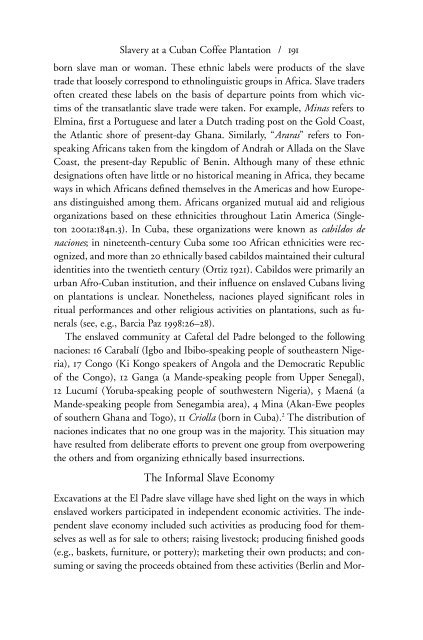Dialogues in Cuban Archaeology
by L. Antonio Curet, Shannon Lee Dawdy, and Gabino La Rosa Corzo
by L. Antonio Curet, Shannon Lee Dawdy, and Gabino La Rosa Corzo
You also want an ePaper? Increase the reach of your titles
YUMPU automatically turns print PDFs into web optimized ePapers that Google loves.
Slavery at a <strong>Cuban</strong> Coffee Plantation / 191<br />
born slave man or woman. These ethnic labels were products of the slave<br />
trade that loosely correspond to ethnol<strong>in</strong>guistic groups <strong>in</strong> Africa. Slave traders<br />
often created these labels on the basis of departure po<strong>in</strong>ts from which victims<br />
of the transatlantic slave trade were taken. For example, M<strong>in</strong>as refers to<br />
Elm<strong>in</strong>a, ¤rst a Portuguese and later a Dutch trad<strong>in</strong>g post on the Gold Coast,<br />
the Atlantic shore of present-day Ghana. Similarly, “Araras” refers to Fonspeak<strong>in</strong>g<br />
Africans taken from the k<strong>in</strong>gdom of Andrah or Allada on the Slave<br />
Coast, the present-day Republic of Ben<strong>in</strong>. Although many of these ethnic<br />
designations often have little or no historical mean<strong>in</strong>g <strong>in</strong> Africa, they became<br />
ways <strong>in</strong> which Africans de¤ned themselves <strong>in</strong> the Americas and how Europeans<br />
dist<strong>in</strong>guished among them. Africans organized mutual aid and religious<br />
organizations based on these ethnicities throughout Lat<strong>in</strong> America (S<strong>in</strong>gleton<br />
2001a:184n.3). In Cuba, these organizations were known as cabildos de<br />
naciones; <strong>in</strong> n<strong>in</strong>eteenth-century Cuba some 100 African ethnicities were recognized,<br />
and more than 20 ethnically based cabildos ma<strong>in</strong>ta<strong>in</strong>ed their cultural<br />
identities <strong>in</strong>to the twentieth century (Ortiz 1921). Cabildos were primarily an<br />
urban Afro-<strong>Cuban</strong> <strong>in</strong>stitution, and their <strong>in</strong>®uence on enslaved <strong>Cuban</strong>s liv<strong>in</strong>g<br />
on plantations is unclear. Nonetheless, naciones played signi¤cant roles <strong>in</strong><br />
ritual performances and other religious activities on plantations, such as funerals<br />
(see, e.g., Barcia Paz 1998:26–28).<br />
The enslaved community at Cafetal del Padre belonged to the follow<strong>in</strong>g<br />
naciones: 16 Carabalí (Igbo and Ibibo-speak<strong>in</strong>g people of southeastern Nigeria),<br />
17 Congo (Ki Kongo speakers of Angola and the Democratic Republic<br />
of the Congo), 12 Ganga (a Mande-speak<strong>in</strong>g people from Upper Senegal),<br />
12 Lucumí (Yoruba-speak<strong>in</strong>g people of southwestern Nigeria), 5 Maená (a<br />
Mande-speak<strong>in</strong>g people from Senegambia area), 4 M<strong>in</strong>a (Akan-Ewe peoples<br />
of southern Ghana and Togo), 11 Criolla (born <strong>in</strong> Cuba). 2 The distribution of<br />
naciones <strong>in</strong>dicates that no one group was <strong>in</strong> the majority. This situation may<br />
have resulted from deliberate efforts to prevent one group from overpower<strong>in</strong>g<br />
the others and from organiz<strong>in</strong>g ethnically based <strong>in</strong>surrections.<br />
The Informal Slave Economy<br />
Excavations at the El Padre slave village have shed light on the ways <strong>in</strong> which<br />
enslaved workers participated <strong>in</strong> <strong>in</strong>dependent economic activities. The <strong>in</strong>dependent<br />
slave economy <strong>in</strong>cluded such activities as produc<strong>in</strong>g food for themselves<br />
as well as for sale to others; rais<strong>in</strong>g livestock; produc<strong>in</strong>g ¤nished goods<br />
(e.g., baskets, furniture, or pottery); market<strong>in</strong>g their own products; and consum<strong>in</strong>g<br />
or sav<strong>in</strong>g the proceeds obta<strong>in</strong>ed from these activities (Berl<strong>in</strong> and Mor-


















